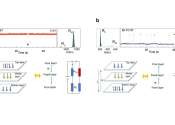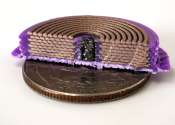A magnet (from Greek μαγνήτις λίθος magnḗtis líthos, "Magnesian stone") is a material or object that produces a magnetic field. This magnetic field is invisible but is responsible for the most notable property of a magnet: a force that pulls on other ferromagnetic materials and attracts or repels other magnets.
A permanent magnet is one made from a material that stays magnetized. An example is a magnet used to hold notes on a refrigerator door. Materials that can be magnetized, which are also the ones that are strongly attracted to a magnet, are called ferromagnetic (or ferrimagnetic). These include iron, nickel, cobalt, some rare earth metals and some of their alloys (e.g. Alnico), and some naturally occurring minerals such as lodestone.
Although ferromagnetic (and ferrimagnetic) materials are the only ones with an attraction strong enough to a magnet to be commonly considered "magnetic", all other substances respond weakly to a magnetic field, by one of several other types of magnetism.
An electromagnet is made from a coil of wire which acts as a magnet when an electric current passes through it, but stops being a magnet when the current stops. Often an electromagnet is wrapped around a core of ferromagnetic material like steel, which enhances the magnetic field produced by the coil.
The overall strength of a magnet is measured by its magnetic moment, while the local strength of the magnetism in a material is measured by its magnetization.









